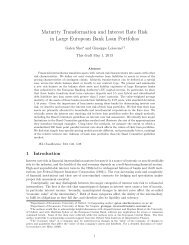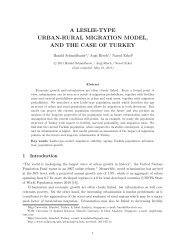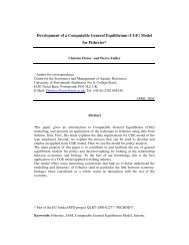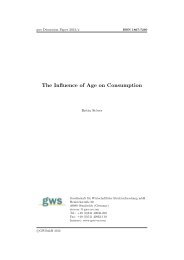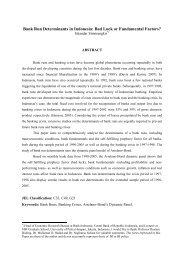Water Scarcity and Virtual Water Trade in the ... - Ecomod Network
Water Scarcity and Virtual Water Trade in the ... - Ecomod Network
Water Scarcity and Virtual Water Trade in the ... - Ecomod Network
Create successful ePaper yourself
Turn your PDF publications into a flip-book with our unique Google optimized e-Paper software.
generated by two global climate models (from CSIRO <strong>and</strong> NCAR), comb<strong>in</strong>ed with <strong>the</strong> CLIRUN IIhydrologic model (Strezepek et al., 2008). The two climate scenarios are labeled “W” (NCAR) <strong>and</strong>“D” (CSIRO), as <strong>the</strong> former predicts a relatively wetter climate, whereas o<strong>the</strong>r one is relativelydrier. 8 We can see that <strong>the</strong> climate models predict a reduction of precipitations <strong>and</strong> run-off for mostMediterranean countries, with dramatic effects for Morocco, whereas some o<strong>the</strong>r countries are notsignificantly affected. In addition to <strong>the</strong> W <strong>and</strong> D cases, we consider an <strong>in</strong>termediate one (labeled“M”), which is a simple average of W <strong>and</strong> D estimates. This latter scenario is <strong>in</strong>troduced to providea central value <strong>and</strong> a sensitivity analysis for our results.We use <strong>the</strong> <strong>in</strong>formation above to simulate <strong>the</strong> climate change effects on agricultural productivity<strong>and</strong> virtual water <strong>in</strong> a general equilibrium model, whose structure is briefly described <strong>in</strong> AppendixA. We consider <strong>the</strong> 2000-2050 percentage change <strong>in</strong> <strong>the</strong> MAR for <strong>the</strong> three scenarios (W, M, D),<strong>and</strong> we assume that <strong>the</strong> multifactor productivity <strong>in</strong> all agricultural sectors varies by <strong>the</strong> samechange, multiplied by <strong>the</strong> WCI. This means that, if a country is already water constra<strong>in</strong>ed, anyreduction <strong>in</strong> surface water availability directly translates <strong>in</strong>to lower yield for all crops. Conversely,if <strong>the</strong> country is only partially constra<strong>in</strong>ed, only some of <strong>the</strong> water change will be felt through <strong>the</strong>productivity impact.Clearly, this work<strong>in</strong>g assumption is a quite strong one. The productivity response to water stress <strong>and</strong>chang<strong>in</strong>g climate conditions depends on <strong>the</strong> specific crop, as well as on a variety of o<strong>the</strong>r factors(e.g., irrigation mode). Unfortunately, no <strong>in</strong>formation is currently available on this aspect,particularly at <strong>the</strong> time <strong>and</strong> space scale of our model, 9 although research <strong>in</strong> this area is <strong>in</strong> progress. 10S<strong>in</strong>ce <strong>the</strong> exogenous shock is <strong>in</strong>troduced <strong>in</strong> <strong>the</strong> general equilibrium model as a shift <strong>in</strong> multifactorproductivity for agriculture, we can expect that <strong>the</strong> new equilibrium will be characterized by loss(ga<strong>in</strong>) of competitiveness for those <strong>in</strong>dustries <strong>and</strong> regions which have high (low) water <strong>in</strong>tensity,whenever water availability is assumed to be lower <strong>in</strong> <strong>the</strong> future. Follow<strong>in</strong>g <strong>the</strong> basic Samuelson-Heckscher-Ohl<strong>in</strong> logic, which can be applied here because <strong>the</strong> CGE model is based on neo-classicassumptions, countries will tend to specialize <strong>in</strong> those productions which are <strong>in</strong>tensive <strong>in</strong> <strong>the</strong> factorswhich are relatively abundant, <strong>in</strong>clud<strong>in</strong>g water. <strong>Trade</strong> flows will adjust accord<strong>in</strong>gly, with morevirtual water flow<strong>in</strong>g towards water-stressed regions.Before exam<strong>in</strong><strong>in</strong>g <strong>the</strong> simulation results <strong>in</strong> terms of virtual water, let us consider some aggregatemacroeconomic <strong>in</strong>dicators, account<strong>in</strong>g for <strong>the</strong> overall impact of <strong>the</strong> vary<strong>in</strong>g water availability onnational <strong>in</strong>come <strong>and</strong> welfare. Table 3 presents simulation results for <strong>the</strong> Gross Domestic Product(GDP) <strong>and</strong> <strong>the</strong> Equivalent Variation (EV). The latter is a measure of welfare, amount<strong>in</strong>g to <strong>the</strong>hypo<strong>the</strong>tical variation <strong>in</strong> <strong>in</strong>come (at constant prices) which would have generated <strong>the</strong> same impact<strong>in</strong> terms of consumer utility of <strong>the</strong> exogenous shocks considered <strong>in</strong> <strong>the</strong> simulations.8 This holds globally, not necessarily at <strong>the</strong> regional level.9 The general equilibrium model considers aggregated agriculture <strong>in</strong>dustries (several crops), with national or largerregions (different climatic zones), at a yearly scale (different vegetation periods).10 For example, improv<strong>in</strong>g aggregate yield response estimates is one objective of <strong>the</strong> European research projectWASSERMed (http://www.wassermed.eu).8




